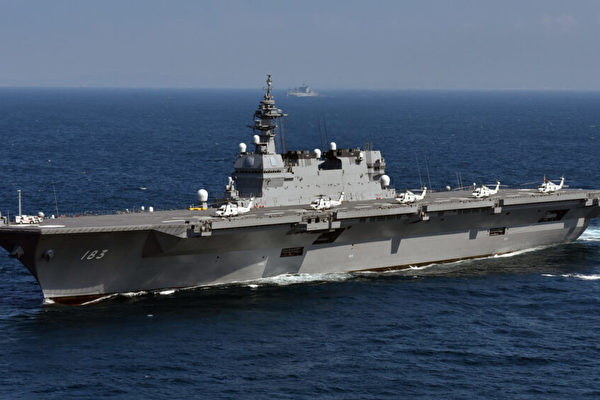The United States Department of Justice is pursuing a rare indictment against a Chinese student for using drones to film a shipyard in Virginia based on anti-spying laws. The shipyard in question is where the U.S. Navy is constructing nuclear submarines. In Japan, the helicopter carrier “Izumo” was also filmed by a drone, with the related videos widely circulated on Chinese social media platforms, highlighting the urgency to enhance drone defense measures for military facilities.
In January, Shi Fengyun, a doctoral student at the University of Minnesota, was arrested on suspicion of espionage for operating a drone near the shipyard in Hampton Roads, Virginia, where he was subsequently found with the video footage of the Virginia-class nuclear submarine construction site. Fengyun was arrested for unauthorized drone operation within 300 meters of the shipyard and now faces six misdemeanor charges related to espionage activities.
Authorities are delving into whether Fengyun had any connections with the Chinese Communist Party, as admitting to such ties could lead to more severe legal consequences. If convicted, each charge could carry up to a year in prison.
In a separate incident in March, aerial footage of the Maritime Self-Defense Force escort ship “Izumo” surfaced on Chinese social media, sparking widespread attention. Defense officials concluded that the video, capturing ship identification numbers, structures, and radar equipment, was likely authentic. Despite being promptly removed, similar content appeared on X (formerly Twitter) and spread rapidly.
The “Izumo” was originally a helicopter-carrying escort vessel and is currently undergoing final stage modifications to accommodate the vertical takeoff and landing F-35B. Given the strategic and military tensions in the Indo-Pacific region with China, the revamped “Izumo” plays a critical role in Japan’s defense, hailed as a “national treasure.”
The account claiming to be the “world’s chief drone espionage artist” also uploaded multiple videos of other U.S. military vessels in Yokosuka Harbor, including the aircraft carrier Abraham Lincoln and Arleigh Burke-class destroyers.
The U.S. Navy Criminal Investigative Service (NCIS) in Yokosuka Base is investigating the veracity of the images, assuring there are no security risks at present. In coordination with the Kanagawa Prefectural Police, searches for small drones violating flight restrictions were initiated. Following the reports, the account posted a message indicating fear of arrest by Japanese authorities and distancing from any association with the Chinese government.
Attempts to contact the account were unsuccessful at the time of publication. Military journalist Yamada Toshihiro analyzed the situation, suggesting the individual involved may not be an official government employee. He emphasized the incongruity of exposing Japan’s defense vulnerabilities compared to maintaining classified information within China.
Addressing security loopholes in Japan’s critical infrastructure, Defense Minister Kihara Minoru expressed deep concern over the incident, emphasizing the need for comprehensive base security enhancements due to the increasing difficulty in detecting drones.
The case against Fengyun is based on anti-spying laws established during World War II, making it exceedingly rare in the United States to prosecute filming activities as espionage.
Experts note that Fengyun’s case represents the first instance of applying anti-spying laws to drone filming, with uncertain consequences post-indictment.
In Japan, the “Small Unmanned Aircraft Flight Prohibition Act” was enacted in 2016, restricting unauthorized drone flights near Self-Defense Forces, U.S. military bases, the Prime Minister’s residence, nuclear reactors, and other significant facilities susceptible to terrorist or espionage attacks. Violations carry potential sentences of less than a year in prison or fines up to 500,000 yen.
Local media in Okinawa Prefecture opposed the legislation, denouncing it as a “blindfold law” that obstructs free speech and movement, asserting a violation of constitutional rights.
Drones are categorized into two types: those autonomously programmed for flight without satellite communication and do not emit radio waves. Addressing the challenging detection of these drones, Senator Haraya Tsuya urged the Defense Ministry to swiftly adopt countermeasures.
The Defense Ministry is contemplating acquiring highly detectable equipment as part of enhanced surveillance measures, potentially introducing specialized radar or UAV systems for countering drones. Deputy Defense Minister Makoto Oniki indicated that upon drone detection, measures such as jamming radio waves to force a landing would be enforced.
English newspaper “Nikkei Asia” reported cases where small drones were mistaken for birds, highlighting operational difficulties in monitoring highly agile drones that might become untraceable.
In the backdrop of wars in Russia and Ukraine, both nations are grappling with drone attacks. Drones, cheaper than missiles and widely available on civilian markets, wield significant asymmetric warfare capabilities.
As drones become smaller and more advanced, nations are on high alert for potential security breaches in military intelligence. Strengthening regulatory frameworks and bolstering defense systems are imperative from a security standpoint.

